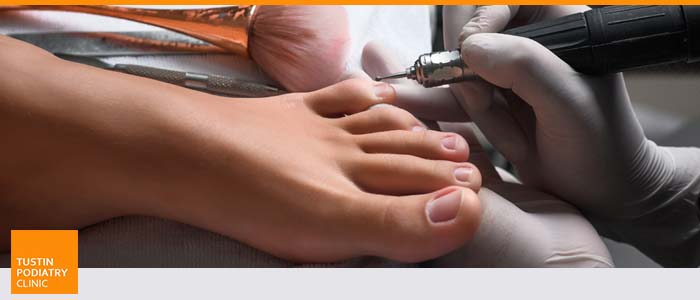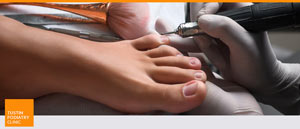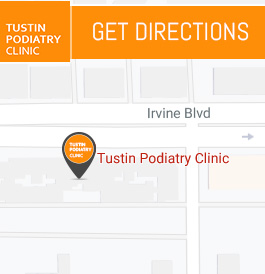4 Questions to Ask Your Podiatrist About Corn Removal
Corns are thickened areas of skin caused by the accumulation of dead cells. They are most commonly found on the feet because of the degree of pressure applied to them on a regular basis. Although corn is neither harmful nor potentially fatal, it can cause an immense amount of pain. Talk to our board-certified podiatric surgeon, Dr. Charles Baik, DPM, today at Tustin Podiatry Clinic about corn removal to help you get rid of the discomfort caused by corn. For more information, contact us or schedule an appointment online! We are conveniently located at 17400 Irvine Blvd. Suite H, Tustin, CA.


Table of Contents:
What are corns?
What is the difference between corns and calluses?
Can corn be prevented?
What happens if a corn goes untreated?
Corns are small, round build-ups of dead skin, with a defined center. They can be either hard or soft, and soft corns tend to have a rubbery texture, often occurring in a response to friction or pressure, and most commonly develop between the toes, where the area is moist, smooth and sweaty. Hard corns are usually smaller, and occur in areas of hard, firm skin and more in bony areas, and commonly where there are calluses formed.
Corns are usually whitish in color and will sometimes look like an open sore that can cause a person pain. For most healthy people, if the corn does cause discomfort, treatment may be necessary, however, simply eliminating the source of friction or pressure can usually cause the corn to disappear.
Anyone who’s spent the day raking leaves, or shoveling snow, and mistakenly overlooked wearing work gloves, has likely felt the beginnings of a callus developing on the hands and fingers. Or, if you purchased a new pair of shoes, and the back of the shoe rubs against the back of the foot above the heel, for an extended period of time. Calluses are formed when a section of skin thickens because of constant friction and pressure, and can also form on the feet and toes. In most cases, a callus does not cause much discomfort, however, if on the foot, the callus can cause significant pain when pressure is placed on it from walking or standing. Because the affected skin of a callus is thick, it may be less sensitive than the skin surrounding it, and could have a lumpy feel. A callus has less defined edges, and is bigger and wider than a corn, and most often will appear where the skin is repeatedly rubbed against a hard surface. Similar to when a blister forms on the skin when breaking in a new pair of shoes, a callus is a signal that the body is in defense mode from a trauma to the skin. Though a blister is a painful, fluid filled area under the surface of the skin, a callus is hardened skin, and usually painless. Calluses generally form over bony areas that are weight bearing, such as the area just under the toes. A particular type of callus, called a plantar callus, forms at the bottom of the heel, and occurs when the bone in one foot is larger than the bone in the other foot, and hits the ground with greater force when walking, causing the skin under the bone to thicken and harden. Corns are typically small and round and may appear on the tops or sides of your toes. Corns may also develop on the hands and fingers.
Given the primary risk factor for developing corn is friction, and pressure on the skin, some of the following can help prevent the development of a corn, on both the hands or feet:
• Wear well-fitting footwear, with well-placed seams
• Wear socks that fit well
• Avoid walking barefoot on hard surfaces as much as possible
• Wear gloves when using hand tools, musical instruments or sports equipment, and when cycling for long periods of time
• Resting elbows on tables for long periods of time
Extended walking on flat surfaces, joint diseases and older age are unfortunately some unavoidable risk factors for the development of corn.
If corn starts to become very painful, and a person has fragile skin, or circulatory conditions, it is a good idea to visit a podiatrist, because the risk of infection increases. As well, there may be an underlying bone structure issue that could require x-rays or possibly surgery.
At Tustin Podiatry Clinic, our highly skilled, extensively trained, and experienced team of foot care experts and Podiatrists, are available to diagnose and treat a wide variety of foot and ankle problems, including the treatment of corns and calluses. To arrange your consultation, call Tustin Podiatry Clinic, or visit our website. We serve patients from Tustin CA, Irvine CA, Garden Grove CA, Orange CA, Anaheim CA, Costa Mesa CA, and Lake Forest CA.

Additional Services You May Need
▸ Heel Pain Treatment
▸ Laser Fungal Nail Treatment
▸ Ingrown Toenail Treatment
▸ Ankle Sprain Treatment
▸ Foot and Ankle Medicine & Surgery
▸ Orthotics Custom
▸ EPAT/Shockwave Therapy
▸ Hammertoe
▸ Arthritis Treatment
▸ Diabetic Foot Care
▸ Flat Feet Treatment
▸ Foot Warts Treatment
▸ ClarixFlo





